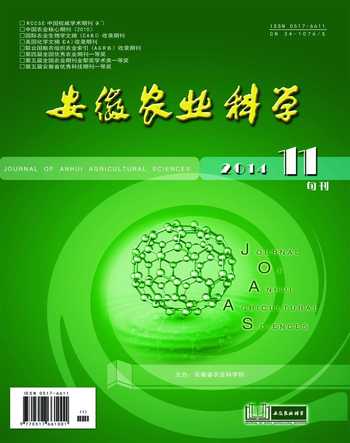甲藻门环胺螺环藻属和环胺螺环藻酸研究进展
刘丽丽
摘要
环胺螺环藻酸(Azaspiracid, AZA)是最近发现的一种贝类毒素,近年来在毒素成分、结构和毒性大小以及产生这类毒素的甲藻物种多样性研究上取得了快速的进展。对产毒藻的物种多样性、地理分布、形态学和系统发育以及毒素成分的研究进展进行了综述。
关键词 甲藻;环胺螺环藻酸;环胺螺环藻属;贝类毒素
中图分类号 S917 文献标识码 A 文章编号 0517-6611(2014)11-03293-03
Abstract Azaspiracid is a recently reported shellfish toxin. In recent years, great progresses have been made on toxin composition, structures, toxicity, and dinoflagellate diversity responsible for these toxins. Here we review the species diversity and biogeography of these toxic dinoflagellates, morphology and phylogeny, and toxin composition.
Key words Dinoflagellate; Azaspiracid; Azadinium; Shellfish toxin
环胺螺环藻酸(Azaspiracid, AZA)是一类聚醚类生物毒素,其结构包括1个环胺(Cyclic amine/aza group)、3个螺环(Trispiroassembly)和1个羧酸(Carboxylic acid),因此得名 AZA-SPIR-ACID。人食用AZA毒素污染的贝类会出现恶心、呕吐、腹泻、胃痉挛等症状,因此欧盟通过立法确立了双壳软体动物中AZA的最大检出限(160 μg/kg贝肉)。在所有已知的海洋贝类毒素中,AZA毒素是最晚发现的一类,但最近几年在产毒藻的分类学研究、毒素衍生物的结构分析等领域取得了飞速的发展。笔者对产毒藻的物种多样性、地理分布、形态学和系统发育以及毒素成分的研究进展进行了综述,并对今后的研究方向进行了展望。
1 环胺螺环藻贝类毒素产毒藻
1.1 物种多样性和地理分布
1995年在荷兰发生了食用贻
贝造成的中毒事件[1],3年后这种毒素被命名为环胺螺环藻酸-1(AZA1)[2]。2009年,AZA毒素被确定是由环胺藻属(Azadinium)的甲藻产生的。迄今为止该属已经描述了7个物种,首先在苏格兰所属的北海发现了具刺环胺藻(Azadinium spinosum)[3],此后从同一个海域发现了肥胖环胺藻(Azadinium obesum)[4],接着在丹麦所属的北海发现了腹孔环胺藻(Azadinium poporum)[5]。2012年,在法国发现的Amphidoma caudata被转移到环胺藻属,并建立了2个变种,尾环胺藻尾变种和尾环胺藻玛格丽变种(var. caudatum 和Azadinium caudata var. Margalefii)[6];同年在苏格兰设德兰群岛又发现了长孔环胺藻(Azadinium polongum)[7]。2013年于地中海发现了右侧环胺藻(Azadinium dexteroporum)[8]。唯一
在欧洲以外发现的物种是大连环胺藻(Azadinium dalianense)[9],分离自我国大连海域。环胺藻除了自由生活外,还可以与放射虫共生[10]。
环胺藻属的生物地理分布信息还十分有限,腹孔环胺藻在韩国和我国海域都有分布[11-12],具刺环胺藻在阿根廷海域引发过赤潮[13],也分布在墨西哥海域[14]。
1.2 形态学
除了尾环胺藻外, 其他的环胺藻无论是大小还是形态都很接近(表1)。已描述的物种都是自养型的,靠近细胞表层有1个叶绿体。大部分种类在光镜下可以看到像环一样的柄状淀粉粒。环胺藻属的甲板方程式是Po,cp,X,4′,3a,6′′,C6,5S,6′′′,2′′′′,唯一的例外是大连环胺藻,其顶板只有3块,前间插板只有2块,因此对环胺藻属的定义也相应进行了修订[9]。环胺藻属的细胞都有1个明显的顶孔复合体,包括1块顶孔板和1块导沟板。顶孔板中央有1个顶孔,被1块盖板盖住。导沟板有特殊的三维结构。5块纵沟板的排列也非常有特点。前纵沟板很大,侵入细胞上壳,左纵沟板狭长,从第2块横沟板一直延伸到第6块横沟板。部分物种的第2块底板有1根很小的刺 (具刺环胺藻,长孔环胺藻和右侧环胺藻)或者1个明显的角 (尾环胺藻)。环胺藻都有1个明显的腹孔,但各个物种腹孔的位置并不相同,是种间区分的重要特征之一(表1)。
1.3 系统发育 3 展望
目前环胺藻属已经发现了7个物种,但是其物种多样性的研究还远未结束,而其生物地理分布的研究则刚刚起步。基于分子序列的定量PCR法和原位杂交荧光检测技术可用于检测水体中的环胺藻[32],该技术不仅可以用于生物地理学的研究,而且可以用于研究产毒环胺藻的季节变化,从而为贝类毒素含量的监测提供依据。
目前大部分环胺螺环藻酸成分的毒性还不清楚,因此研究各种成分,尤其是AZA-40、AZA-41等成分的毒性是今后急需开展的工作,对这些新发现的毒素成分结构进行研究则有助于理解毒性大小的变化。转录组学技术的发展为寻找相关的环胺螺环藻酸基因提供了可能,由于同一物种存在有毒株和无毒株,因此发展针对产毒基因的检测技术更具有针对性。
参考文献
[1]
MCMAHON T,SILKE J.Winter toxicity of unknown aetiology in mussels[J].Harmful Algae News,1996,14:2.
[2] SATAKE M,OFUJI K,NAOKI H,et al.Azaspiracid,a new marine toxin having unique spiro ring assemblies,isolated from Irish mussels,Mytilus edulis[J].Journal of the American Chemical Society,1998,120(38):9967-9968.
[3] TILLMANN U,ELBRCHTER M,KROCK B,et al.Azadinium spinosum gen.et sp.nov.(Dinophyceae) identified as a primary producer of azaspiracid toxins[J].European Journal of Phycology,2009,44(1):63-79.
[4] TILLMANN U,ELBRCHTER M,JOHN U,et al.Azadinium obesum (Dinophyceae),a new nontoxic species in the genus that can produce azaspiracid toxins[J].Phycologia,2010,49(2):169-182.
[5] TILLMANN,U,ELBRCHTER M,JOHN U,et al.A new non-toxic species in the dinoflagellate genus Azadinium:A.poporum sp.nov[J].European Journal of Phycology,2011,46(1):74-87.
[6] NZAN E,TILLMANN U,BILIEN G,et al.Taxonomic revision of the dinoflagellate Amphidoma caudata:transfer to the genus Azadinium (Dinophyceae) and proposal of two varieties,based on morphological and molecular phylogenetic analyses[J].Journal of Phycology,2012,48:925-939.
[7] TILLMANN U,SOEHNER S,NZAN E,et al.First record of the genus Azadinium (Dinophyceae) from the Shetland Islands,including the description of Azadinium polongum sp.nov[J].Harmful Algae,2012,20:142-155.
[8] PERCOPO I,SIANO R,ROSSI R,et al.A new potentially toxic Azadinium species (Dinophyceae) from the Mediterranean Sea,A.dexteroporum sp.nov[J].Journal of Phycology,2013,49:950-966.
[9] LUO Z,GU H,KROCK B,et al.Azadinium dalianense,a new dinoflagellate species from the Yellow Sea,China[J].Phycologia,2013,52(6):625-636.
[10] DECELLE J,SIANO R,PROBER I,et al.Multiple microalgal partners in symbiosis with the acantharian Acanthochiasma sp.(Radiolaria)[J].Symbiosis,2012,58(1/3):233-244.
[11] POTVIN ,JEONG H J,KANG N S,et al.First report of the photosynthetic dinoflagellate genus Azadinium in the Pacific Ocean:Morphology and molecular characterization of Azadinium cf.poporum[J].Journal of Eukaryotic Microbiology,2011,59:145-156.
[12] GU H,LUO Z,KROCK B,et al.Morphology,phylogeny and azaspiracid profile of Azadinium poporum (Dinophyceae) from the China Sea[J].Harmful Algae,2013,21/22:64-75.
[13] AKSELMAN R,NEGRI R M.Blooms of Azadinium cf.spinosum Elbrchter et Tillmann (Dinophyceae) in northern shelf waters of Argentina,Southwestern Atlantic[J].Harmful Algae,2012,19:30-38.
[14] HERNNDEZBECERRIL D U,BARNCAMPIS SA,ESCOBARMORALES S.A new record of Azadinium spinosum (Dinoflagellata) from the tropical Mexican Pacific[J].Revista de Biología Marina y Oceanografía,2012,47(3):553-557.
[15] GU H,KIRSCH M,ZINSSMEISTER C,et al.Waking the Dead:Morphological and Molecular Characterization of Extant Posoniella tricarinelloides (Thoracosphaeraceae,Dinophyceae)[J].Protist,2013,164(5):583-597.
[16] OFUJI K,SATAKE M,MCMAHON T,et al.Structures of azaspiracid analogs,azaspiracid4 and azaspiracid-5,causative toxins of azaspiracid poisoning in Europe[J].Bioscience,Biotechnology,and Biochemistry,2001,65(3):740-742.
[17] OFUJI K,SATAKE M,MCMAHON T,et al.Two analogs of azaspiracid isolated from mussels,Mytilus edulis,involved in human intoxication in Ireland[J].Natural Toxins,1999,7(3):99-102.
[18] JAMES K J,SIERRA M D,LEHANE M,et al.Detection of five new hydroxyl analogues of azaspiracids in shellfish using multiple tandem mass spectrometry[J].Toxicon,2003,41(3):277-283.
[19] REHMANN N,HESS P,QUILLIAM M A.Discovery of new analogs of the marine biotoxin azaspiracid in blue mussels (Mytilus edulis) by ultra-performance liquid chromatography/tandem mass spectrometry[J].Rapid Communications in Mass Spectrometry,2008,22(4):549-558.
[20] KROCK B,TILLMANN U,VOSS D,et al.New azaspiracids in Amphidomataceae (Dinophyceae)[J].Toxicon,2012,60(5):830-839.
[21] KROCK B,TILLMANN U,WITT M,et al.Azaspiracid variability of Azadinium poporum (Dinophyceae) from the China Sea[J].Harmful Algae,2014,in press.
[22] JAMES K J,FUREY A,LEHANE M,et al.First evidence of an extensive northern European distribution of azaspiracid poisoning (AZP) toxins in shellfish[J].Toxicon,2002,40(7):909-915.
[23] LVAREZ G,URIBE E,VALOS P,et al.First identification of azaspiracid and spirolides in Mesodesma donacium and Mulinia edulis from Northern Chile[J].Toxicon,2010,55(2/3):638-641.
[24] KLONTZ K C,ABRAHAM A,PLAKAS S M,et al.Mussel-associated azaspiracid intoxication in the United States[J].Annals of Internal Medicine,2009,150(5):361.
[25] MAGDALENA A B,LEHANE M,KRYS S,et al.The first identification of azaspiracids in shellfish from France and Spain[J].Toxicon,2003,42(1):105-108.
[26] TALEB H,VALE P,AMANHIR R,et al.First detection of azaspiracids in mussels in north west Africa[J].Journal of Shellfish Research,2006,25(3):1067-1070.
[27] UEOKA R,ITO A,IZUMIKAWA M,et al.Isolation of azaspiracid2 from a marine sponge Echinoclathria sp.as a potent cytotoxin[J].Toxicon,2009,53(6):680-684.
[28] 姚建华,谭志军,周德庆,等.液相色谱-串联质谱法检测贝类产品中的原多甲藻酸贝类毒素[J].色谱,2010,28(4):363-367.
[29] JAUFFRAIS T,SCHET V,HERRENKNECHT C,et al.Effect of environmental and nutritional factors on growth and azaspiracid production of the dinoflagellate Azadinium spinosum[J].Harmful Algae,2013,27:138-148.
[30] ITO E,TERAO K,MCMAHON T,et al.Acute pathological changes in mice caused by crude extracts of novel toxins isolated from Irish mussels[C]//HARMFUL ALGAE,REGUERA B,BLANCO J,et al.Eds.Santiago de Compostela:Xunta de Galicia and Intergovernmental Oceanographic Commission of UNESCO,1998:588-589.
[31] TWINER M J,REHMANN N,HESS P,et al.Azaspiracid shellfish poisoning:a review on the chemistry,ecology,and toxicology with an emphasis on human health impacts[J].Marine Drugs,2008,6(2):39-72.
[32] TOEBE K,JOSHI A R.Molecular discrimination of taxa within the dinoflagellate genus Azadinium,the source of azaspiracid toxins[J].Journal of Plankton Research,2013,35(1):225-230.
——以汝溪河为例
——阿米巴藻Amoebophrya spp.的研究进展

